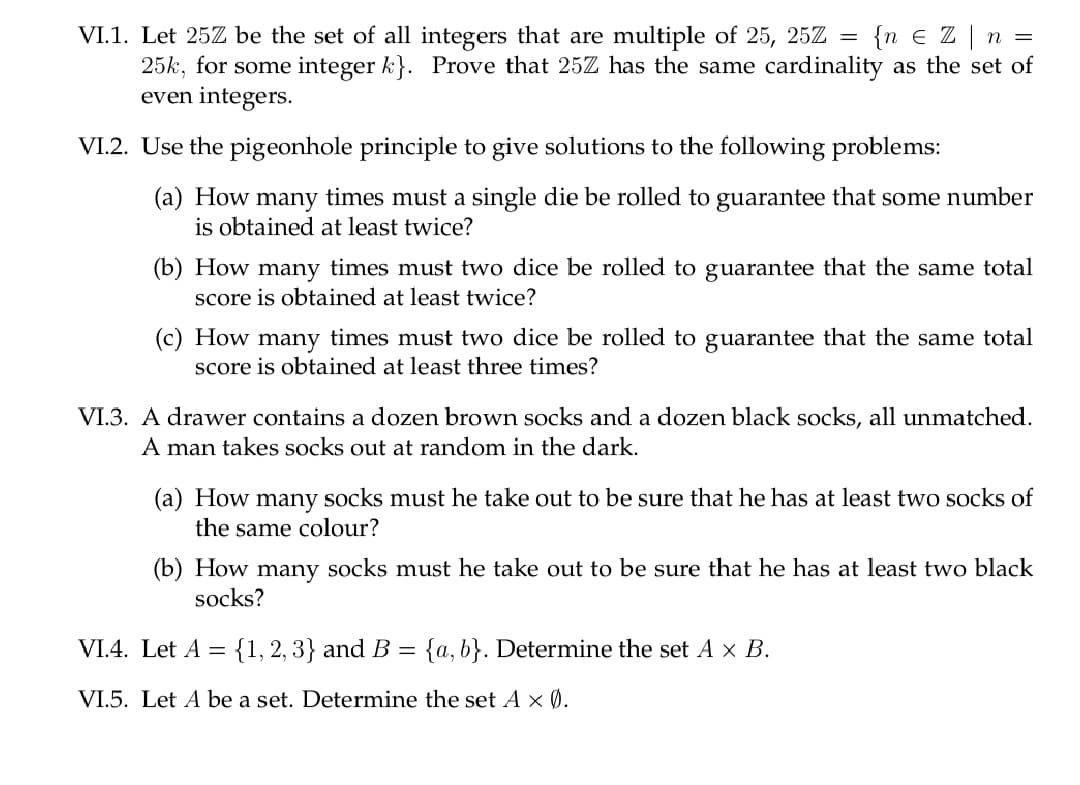is obtained at least twice? (b) How many times must two dice be rolled to guarantee that score is obtained at least twice? (c) How many times must two dice be rolled to guarantee that score is obtained at least three times? A drawer contains a dozen brown socks and a dozen black socks, A man takes socks out at random in the dark. (a) How many socks must he take out to be sure that he has at le the same colour? (b) How many socks must he take out to be sure that he has at socks? Let A = {1, 2, 3} and B = {a, b}. Determine the set A x B. %3D Let A be a set. Determine the set A x 0.
is obtained at least twice? (b) How many times must two dice be rolled to guarantee that score is obtained at least twice? (c) How many times must two dice be rolled to guarantee that score is obtained at least three times? A drawer contains a dozen brown socks and a dozen black socks, A man takes socks out at random in the dark. (a) How many socks must he take out to be sure that he has at le the same colour? (b) How many socks must he take out to be sure that he has at socks? Let A = {1, 2, 3} and B = {a, b}. Determine the set A x B. %3D Let A be a set. Determine the set A x 0.
Linear Algebra: A Modern Introduction
4th Edition
ISBN:9781285463247
Author:David Poole
Publisher:David Poole
Chapter2: Systems Of Linear Equations
Section2.4: Applications
Problem 33EQ
Related questions
Question

Transcribed Image Text:= {n e Z |
VI.1. Let 25Z be the set of all integers that are multiple of 25, 25Z =
25k, for some integer k}. Prove that 25Z has the same cardinality as the set of
even integers.
VI.2. Use the pigeonhole principle to give solutions to the following problems:
(a) How many times must a single die be rolled to guarantee that some number
is obtained at least twice?
(b) How many times must two dice be rolled to guarantee that the same total
score is obtained at least twice?
(c) How many times must two dice be rolled to guarantee that the same total
score is obtained at least three times?
VI.3. A drawer contains a dozen brown socks and a dozen black socks, all unmatched.
A man takes socks out at random in the dark.
(a) How many socks must he take out to be sure that he has at least two socks of
the same colour?
(b) How
socks?
many socks must he take out to be sure that he has at least two black
VI.4. Let A ={1, 2, 3} and B = {a,b}. Determine the set A × B.
VI.5. Let A be a set. Determine the set A × Ø.
Expert Solution
This question has been solved!
Explore an expertly crafted, step-by-step solution for a thorough understanding of key concepts.
Step by step
Solved in 3 steps with 28 images

Recommended textbooks for you

Linear Algebra: A Modern Introduction
Algebra
ISBN:
9781285463247
Author:
David Poole
Publisher:
Cengage Learning

Elements Of Modern Algebra
Algebra
ISBN:
9781285463230
Author:
Gilbert, Linda, Jimmie
Publisher:
Cengage Learning,

Algebra & Trigonometry with Analytic Geometry
Algebra
ISBN:
9781133382119
Author:
Swokowski
Publisher:
Cengage

Linear Algebra: A Modern Introduction
Algebra
ISBN:
9781285463247
Author:
David Poole
Publisher:
Cengage Learning

Elements Of Modern Algebra
Algebra
ISBN:
9781285463230
Author:
Gilbert, Linda, Jimmie
Publisher:
Cengage Learning,

Algebra & Trigonometry with Analytic Geometry
Algebra
ISBN:
9781133382119
Author:
Swokowski
Publisher:
Cengage